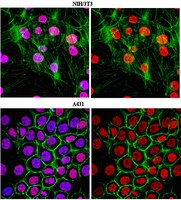05-1951 Sigma-AldrichAnti-trimethyl Histone H3 (Lys27) Antibody, clone 18E9.1
Anti-trimethyl Histone H3 (Lys27) Antibody, clone 18E9.1 is a mouse monoclonal antibody for detection of trimethyl Histone H3 (Lys27) also known as H3K27me3, Histone H3 (tri methyl K27) & has been validated in WB, ICC.
More>> Anti-trimethyl Histone H3 (Lys27) Antibody, clone 18E9.1 is a mouse monoclonal antibody for detection of trimethyl Histone H3 (Lys27) also known as H3K27me3, Histone H3 (tri methyl K27) & has been validated in WB, ICC. Less<<Recommended Products
Overview
| Replacement Information |
|---|
Key Specifications Table
| Species Reactivity | Key Applications | Host | Format | Antibody Type |
|---|---|---|---|---|
| H, M | WB, ICC, DB | M | Purified | Monoclonal Antibody |
| References |
|---|
| Product Information | |
|---|---|
| Format | Purified |
| Control |
|
| Presentation | Purified mouse monoclonal IgG2bκ in buffer containing 0.1 M Tris-Glycine (pH 7.4), 150 mM NaCl with 0.05% sodium azide. |
| Quality Level | MQ100 |
| Physicochemical Information |
|---|
| Dimensions |
|---|
| Materials Information |
|---|
| Toxicological Information |
|---|
| Safety Information according to GHS |
|---|
| Safety Information |
|---|
| Storage and Shipping Information | |
|---|---|
| Storage Conditions | Stable for 1 year at 2-8°C from date of receipt. |
| Packaging Information | |
|---|---|
| Material Size | 100 µL |
| Transport Information |
|---|
| Supplemental Information |
|---|
| Specifications |
|---|
| Global Trade Item Number | |
|---|---|
| Catalog Number | GTIN |
| 05-1951 | 04053252641510 |
Documentation
Anti-trimethyl Histone H3 (Lys27) Antibody, clone 18E9.1 SDS
| Title |
|---|











